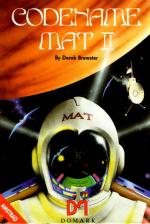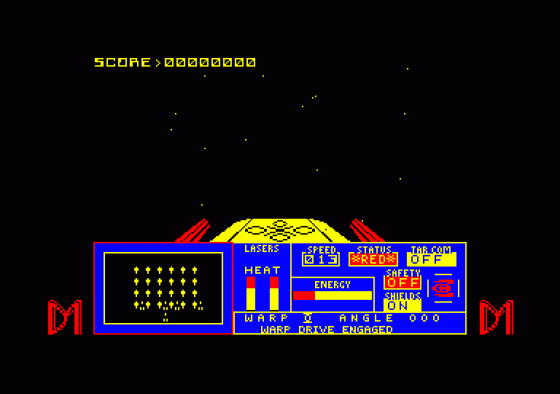
Amstrad Computer User
 1st December 1985
1st December 1985
Codename Mat 2
Back in the early days of the machine, the first game I ever bought was Codename Mat, In this game, you were given the task of ridding the solar system of the dreaded Myons before they reached Earth. At the time, the game was notable for the fact that it provided very fast 3-D combat sequences and started an almighty argument about which way up the controls should work (I still maintain that something attempting to simulate flight should use controls in the same orientation as an aircraft - which it did). One of the major weaknesses of the game was the warp sequence which a lot of people found quite tricky (though it was really quite easy after a little practice).
Personally, I found the game a bit too simple and could complete it every time. Now, a year or more later, along comes Codename Mat 2, The question is: 'How has it changed?' An immediate answer to this would have to be: 'Not very much.' However, after playing the new version for some time I would concede that is probably a much better game, though it is questionable whether it would be worth adding both to one's collection of games. Warping is infinitely easier and the whole game is much more playable.
This time around, the task in hand is to keep the supplies of an important mineral flowing. This involves defending rows of satellites in the supply chain. Old Codename Mat fans will be pleased to know that the five speed control keys are the same, the most useful of which will probably be 4 and 5 which take the ship to 30% and 100% respectively. As before, the ship has shields that must be switched on at the start and which it is unwise to switch off again - the reason why this tedious task has not been automated eludes me. In the original, sector scans, long and short range scanners and quadrant maps were given on separate screens, this has been improved to show them on a small screen on the control panel, which appears much more realistic. The old business of trying to determine the enemies' position using digital range, offset latitude and longitude meters has been replaced by a much more user friendly battle computer that gives a bar graph for range and an X-Y scan showing which direction to steer to bring him into your sights, colour giving an indication of whether he is in front or behind. The fighting is just as zappy as before and is improved by the choice of slow and accurate plasma bolts or fast firing lasers. There appear to be many more ship designs than before, though only one type is encountered in each wave - I can't decide whether each have their own speed and movement attributes, as was the case in the old game.
The idea is to kill off all the Myons before they can nobble the one of the four rows of satellites. At the end of each attack wave an opportunity is given to either repair any that are damaged or to move them about to maintain as many filled rows as possible. In fact, the strategy while fighting is to take on those craft that are most likely to break another link in any particular row. Inevitably, damage will be sustained during fighting but unlike the old game when one could fly to a nearby planet for repairs, your ship contains two droids which can be set to repair the most needy mechanism. This continues as a background task - a message on the console indicating when a system is back to full health, when the droids may then be re-deployed. The long and short range scanners operate in the same way as in the old game (though I'm not sure how many people understood them then).
All in all, the game appears to be a little better than the original, but a bit similar and not a huge improvement this is a shame, because there have been a whole heap of good games in the last year which do tend to make this one look a little dated. However, it is pretty reasonable for a good blast, even after a tough testing I still remain quite proud of the fact that I got to attack wave seven in my first go.






